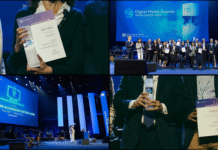At its recent AGM for the year 2022-23, the Association of Indian Magazines (AIM) elected Anant Nath, executive publisher at Delhi Press, as its new president. Manoj Sharma, CEO of publishing at the India Today Group, Dhaval Gupta, managing director of CyberMedia, and Annurag Batra, founder of the Exchange4Media Group, were respectively appointed as the Association’s vice-president, general secretary, and treasurer.
Elected to the AIM governing body were B Srinivasan (Vikatan Group), Maneck Davar (Spenta Multimedia), R Rajmohan (Malayala Manorama), Pradeep Gupta (CyberMedia), Mahesh Peri (Pathfinder Publishing), Paresh Nath (Delhi Press), Riyad Mathew (Malayala Manorama), Girish Mallya (Next Gen Publishing), Deepak Lamba (Worldwide Media), Indranil Roy (Outlook Publishing) and Manan Kotak (Chitralekha).
The Association of Indian Magazines is widely considered the first industry representation for magazines in the country. The Association aims to support and defend the freedom of the press and promote the cause of magazines. Bringing together magazine publishers to establish their better understanding, cooperation, and unity, it aims to consolidate the magazine industry’s views and is a registered society under the Societies Registration Act of 1860.
Tackling the distribution challenges in the country
Indian Printer & Publisher recently interacted with Nath at the Delhi Press office in Jhandewalan in New Delhi where he spoke about his vision for the Association in his term. The Association has been working very proactively on two aspects – fixing the distribution problem in the country, and strengthening the case for magazine advertising, he said.
“Distribution has required the biggest effort because, during the Covid-19 pandemic, the system collapsed. Even before that, the distribution system was generally weaker for magazines because newsstands were diminishing in viability. All of us were facing the problem of newsstand numbers falling, as their owners were not getting sufficient business returns the general incentive to push the magazines was declining,” he explained.
“To circumvent that problem, we decided to find solutions,” Nath said, “adding that all the members of the Association felt that the demand for print magazines is still much higher than what the current circulation numbers are, irrespective of all the changes in reader habits from print to digital.”
“Magazines in India have been very under-serviced, and the number of magazines being sold in the country is a very small percentage of the number of newspapers. “Even though readers have shifted to digital, the universe of those who want to read print is still much higher than we are servicing. We are not able to reach out to them while reaching them via the old distribution system has completely collapsed. We have been working on resurrecting or rather reintroducing the subscription system in a far more effective manner,” Nath said.
In the past 80 years of Indian magazines, most publishers have relied on newsstand sales for about 90 to 95 % of individual copy sales, with subscriptions amounting to single-digit percentages. If one looks at the US or European magazine business models, their subscriptions are almost 80 – 90 % of sales and newsstands bring in only 10%.
“The cost of servicing newsstands presents costs and difficulties. During the Covid pandemic and its aftermath, distribution became even more difficult as newsstands shut down,” he added, saying, “We have collaborated primarily on fixing the subscription delivery system in the country. The reason why subscriptions have never really taken off is because magazine subscription delivery in India has been very poor.”
India Post is very unreliable with magazines either reaching late or not reaching customers at all, Nath said. The Association reached out to the post offices in a series of meetings, explaining that for the magazine industry to survive, the Indian postal system needs to work far more efficiently.
The new Magazine Post service
“As a result, in March 2022, India Post introduced a new service called Magazine Post, in which they have promised a Speed Post kind of delivery at a concessional rate. While Speed Post charges anywhere between Rs 25 and Rs 40 per copy, the new service is delivering magazines at Rs 8-12 depending on city to city or city to outside state. They have completely overhauled the distribution system by introducing alerts to readers on their mobile phones that your magazines have been dispatched, or delivered – like you receive for your eCommerce purchases,” he said.
Readers had two problems – the magazines were not delivered, and they had no information about them, Nath said. India Post has solved both these problems by guaranteeing a 48-72 hours delivery depending on the distances to outskirts or remote regions.
The Association has also set up a distribution program, trying to consolidate a certain set of distribution agents. The Accreditation of Magazine Distribution Agents works with a common pool of agents so that their incentives are higher and they can push the magazines.
Nath said the Association is working with several eCommerce players to partner distribution. “We did a collaboration with BlinkIT earlier in the year, where the BlinkIT app has a Magazine widget in certain cities where readers can order a single copy of the magazine. They did the first trial in New Delhi, where they got very good numbers. Now, BlinkIT is moving the feature to eight or nine cities, including Mumbai, Pune, Bengaluru, and Kolkata. The idea is to take this feature to 21 cities across the country,” he added.
Nath says readers find the biggest deterrent to purchasing a magazine is that they don’t want to go to the market to buy one. Apart from the effort, newsstands are difficult to locate, and as a result, you don’t even know where to buy the magazines or if the one you want is available.
“The publishers together are working to create a system where they can sell the reader either a subscription or a single copy and efficiently deliver and inform. We are in the advanced stage of talks with one of the logistics partners for eCommerce companies such as Amazon and 1mg where our negotiation is that if we were to give them an order for one magazine, can they deliver within 24 hours and can send an SMS alert to the reader?” he shared.
India has thousands of news morning distribution centers with delivery boys, who have been delivering newspapers to homes for many years. They know the newspaper preferences of each household and, therefore, have a pulse on reading habits. The Association is also trying to create an app that will work with these morning center vendors where they can be subscription agents and they can make magazine recommendations to customers based on their reading habits. They will book magazine subscriptions, thereby earning a commission, and the publisher will get an order and the reader will benefit from assured delivery. These morning center distributors, vendors, and delivery resources have unlimited potential for selling subscriptions.
A hub for advertising sales and branded content
“The Association is also collaborating to create a unified network with the membership of eight or nine publishers with a joint studio for branded content for advertisers since most of us are getting a lot of advertising not on display but on branded content,” Nath said. “One of the problems that we face in the market is that magazines are seen as smaller audience products. However, our analysis shows that our combined titles are reaching almost 120 million (12 to 15 crore) readers across our magazines, websites, and social media.
“Like OneIndia, which at one point offered combined advertising opportunities across some eight or nine publishers, we have created a joint studio called Dastaan Hub. The idea is to go to advertisers who want to engage in storytelling in multiple Indian languages in health, personal care, automotive, and parenting.
“Among us, we cover 10 Indian languages. We have magazine publishers who have editorial teams that can create content about these sectors. We want to tell the brands that among our 40 or 50 magazines, we have the content creation capability for any kind of branded content in text, video, and digital and can market the content across our joint properties with the revenue being shared among us,” he said.
The idea is that the marketer will get access to some 40-50 magazines together with social media handles and creative energy through a single window. Customizable solutions can provide a palette of languages, domain relevance, and scale. “We are trying to get a larger number of members on board so that we can have a larger number of publishers in the group,” Nath concluded.


















